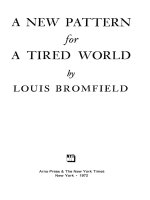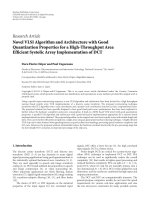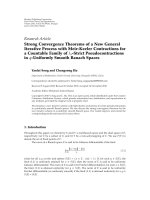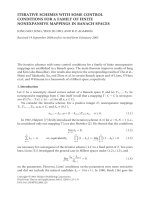Learn functional programming with elixir new foundations for a new world
Bạn đang xem bản rút gọn của tài liệu. Xem và tải ngay bản đầy đủ của tài liệu tại đây (2.88 MB, 191 trang )
Early praise for Functional Programming with Elixir
Learning to program in a functional style requires one to think differently. When
learning a new way of thinking, you cannot rush it. I invite you to read the book
slowly and digest the material thoroughly. The essence of functional programming
is clearly laid out in this book and Elixir is a good language to use for exploring
this style of programming.
➤ Kim Shrier
Independent Software Developer, Shrier and Deihl
Some years ago it became apparent to me that functional and concurrent programming is the standard that discriminates talented programmers from everyone else.
Elixir’s a modern functional language with the characteristic aptitude for crafting
concurrent code. This is a great resource on Elixir with substantial exercises and
encourages the adoption of the functional mindset.
➤ Nigel Lowry
Company Director and Principal Consultant, Lemmata
This is a great book for developers looking to join the world of functional programming. The author has done a great job at teaching both the functional paradigm
and the Elixir programming language in a fun and engaging way.
➤ Carlos Souza
Software Developer, Pluralsight
This book covers the functional approach in Elixir very well. It is great for beginners
and gives a good foundation to get started with advanced topics like OTP, Phoenix,
and metaprogramming.
➤ Gábor László Hajba
Senior Consultant, EBCONT enterprise technologies
Hands down the best book to learn the basics of Elixir. It’s compact, easy to read,
and easy to understand. The author provides excellent code examples and a great
structure.
➤ Stefan Wintermeyer
Founder, Wintermeyer Consulting
Learn Functional Programming with Elixir
New Foundations for a New World
Ulisses Almeida
The Pragmatic Bookshelf
Raleigh, North Carolina
Many of the designations used by manufacturers and sellers to distinguish their products
are claimed as trademarks. Where those designations appear in this book, and The Pragmatic
Programmers, LLC was aware of a trademark claim, the designations have been printed in
initial capital letters or in all capitals. The Pragmatic Starter Kit, The Pragmatic Programmer,
Pragmatic Programming, Pragmatic Bookshelf, PragProg and the linking g device are trademarks of The Pragmatic Programmers, LLC.
Every precaution was taken in the preparation of this book. However, the publisher assumes
no responsibility for errors or omissions, or for damages that may result from the use of
information (including program listings) contained herein.
Our Pragmatic books, screencasts, and audio books can help you and your team create
better software and have more fun. Visit us at .
The team that produced this book includes:
Publisher: Andy Hunt
VP of Operations: Janet Furlow
Managing Editor: Brian MacDonald
Supervising Editor: Jacquelyn Carter
Series editor: Bruce A. Tate
Copy Editor: Candace Cunningham, Nicole Abramowitz
Indexing: Potomac Indexing, LLC
Layout: Gilson Graphics
For sales, volume licensing, and support, please contact
For international rights, please contact
Copyright © 2018 The Pragmatic Programmers, LLC.
All rights reserved.
No part of this publication may be reproduced, stored in a retrieval system, or transmitted,
in any form, or by any means, electronic, mechanical, photocopying, recording, or otherwise,
without the prior consent of the publisher.
Printed in the United States of America.
ISBN-13: 978-1-68050-245-9
Encoded using the finest acid-free high-entropy binary digits.
Book version: P1.0—February 2018
Contents
Acknowledgments
Introduction .
.
.
.
.
.
.
.
.
.
.
.
.
.
.
.
.
.
.
.
.
.
.
.
vii
ix
1.
Thinking Functionally
.
.
.
Why Functional?
Working with Immutable Data
Building Programs with Functions
Declaring Code
Wrapping Up
.
.
.
.
.
.
.
1
1
3
4
7
9
2.
Working with Variables and Functions
.
Representing Values
Executing Code and Generating a Result
Binding Values in Variables
Creating Anonymous Functions
Naming Functions
Wrapping Up
.
.
.
11
11
12
15
17
24
30
3.
Using Pattern Matching to Control the Program Flow .
Making Two Things Match
Unpacking Values from Various Data Types
Control Flow with Functions
Expanding Control with Guard Clauses
Elixir Control-Flow Structures
Wrapping Up
.
.
33
33
35
45
48
53
56
4.
Diving into Recursion
.
Surrounded by Boundaries
Conquering Recursion
Tail-Call Optimization
Functions Without Borders
.
.
59
59
65
70
73
.
.
.
.
.
.
.
.
.
Contents
Using Recursion with Anonymous Functions
Wrapping Up
• vi
78
79
5.
Using Higher-Order Functions
.
.
.
Creating Higher-Order Functions for Lists
Using the Enum Module
Using Comprehensions
Pipelining Your Functions
Be Lazy
Wrapping Up
6.
Designing Your Elixir Applications .
.
.
.
Starting Your Project with Mix
Designing Entities with Structs
Using Protocols to Create Polymorphic Functions
Creating Module Behaviours
Wrapping Up
.
.
.
105
105
110
117
124
136
7.
Handling Impure Functions .
.
.
.
.
.
Pure vs. Impure Functions
Controlling the Flow of Impure Functions
Trying, Rescuing, and Catching
Handling Impure Functions with the Error Monad
Using with
Wrapping Up
.
.
.
139
140
143
146
150
155
158
A1. Adding Rooms to the Game .
.
.
.
.
.
.
.
.
A2. Answers to Exercises .
.
.
.
.
.
.
.
.
.
Answers for Chapter 2, Working with Variables and Functions
Answers for Chapter 3, Using Pattern Matching to Control the
Program Flow
Answers for Chapter 4, Diving into Recursion
Answers for Chapter 5, Using Higher-Order Functions
161
165
165
Bibliography
Index .
.
.
.
.
.
.
.
.
.
.
.
.
.
.
.
.
.
.
.
.
.
.
.
.
.
.
.
.
.
.
81
81
87
89
89
93
102
166
168
171
175
177
Acknowledgments
When it is your first time writing a book, it’s a great challenge. But when
English isn’t your native language, it’s a challenge on a whole new level. I did
it, but I wasn’t alone. This book has reached this level of quality with the help
of several amazing and kind people. I would like to highlight my editor,
Jackie Carter. Her contribution is what makes the release of this book possible.
Her experience and knowledge guided me in the right direction with patience
and humor. We faced tough decisions, rewrites, and corrections, and she was
always there to help and keep me motivated. I’m really grateful to have worked
with her.
Bruce Tate, the series editor, took the first technical look at the book early
in the writing process. His experience was invaluable to me. He helped me
transform introductions from boring to engaging, and helped me prioritize
the essential and useful functional programming techniques.
The Elixir core members Andrea Leopardi and James Fish provided great
technical advice throughout the writing of this book. Our technical reviewers
did superb work in catching broken code and pointing out concepts that
needed more clarity: thank you to Bernardo Araujo, Stéfanni Brasil, João
Britto, Thiago Colucci, Mark Goody, Gábor László Hajba, Maurice Kelly, Nigel
Lowry, Max Pleaner, Juan Ignacio Rizza, Kim Shrier, Carlos Souza, Elomar
Souza, and Richard Thai. Thank you also to our beta reviewers who did an
excellent job in reporting issues, especially Luciano Ramalho, who shared his
experience by providing excellent insights for the first examples of this book.
Thank you to Susannah Davidson Pfalzer for the excellent onboarding to The
Pragmatic Bookshelf, and for the early tips on how to write a great book;
Candace Cunningham, our copyeditor, who helped make the text fluid and
enjoyable to read; Janet Furlow, who helped with production details and
extractions; and Katharine Dvorak, who did an amazing job in guiding the
book through the final steps. She was always ready to answer any questions
and help me with book promotion.
report erratum • discuss
Acknowledgments
• viii
Thank you to Hugo Baraúna from Plataformatec and Adriano Almeida from
Casa do Código for introducing me to The Pragmatic Bookshelf; and to my
coworkers from Plataformatec, who helped keep me motivated, especially João
Britto and José Valim, who always helped me answer hard questions about
Elixir.
Finally, I want to thank my family—Ana Guerra, Sandra Regina, and Thamiris
Herrera—and friends for helping me focus on this project and filling me with
good energy. Thanks to them, I was able to keep my motivation to work hard
and finish the book.
report erratum • discuss
Introduction
As a child, I played many games that were very similar—games like Super
Mario Bros., Donkey Kong, The Lion King, and Aladdin. I could switch between
them without much work; the learning ramp-up was quick. They all shared
the same core mechanics: you move straight to the right, jump on platforms,
and avoid being hit by enemies. They were all 2D platform games.
Switching between programming languages is similar. In my work, I have
needed to switch between Ruby, JavaScript, and CoffeeScript, and between
Java, Python, and Objective-C. It wasn’t too painful to do. All these languages
are very different, but in some ways they are similar. I could use object-oriented programming with all of them. When I learned how to create objects
and methods, all the dots started to connect and the languages became
familiar quickly.
After playing 2D platform games, I switched to fighting games. They were still
games. They were still 2D. However, the challenges and mechanics were
completely different. Instead of going straight to the right and jumping the
obstacles, I needed to punch and kick the enemies in a limited space. I
needed to think differently to master this type of game.
That’s how I felt when I switched to functional programming. Where were my
objects and methods? I made the mistake of applying the concepts that I was
used to in a paradigm where they aren’t necessary. I was messing up the
codebase. I needed to change my thinking. I couldn’t program like I had before.
Switching to a new paradigm is very different from simply switching between
languages. You need to think differently, or you’ll get in trouble.
I invite you to reset your mind before learning functional programming. After
reading this book you’ll see your old code from a very different perspective.
The best part is that most of today’s main languages support some functional
concepts. Even if you can’t switch to Elixir today, you’ll be able to apply useful
functional concepts in your daily language.
report erratum • discuss
Introduction
•x
Is This Book for You?
This book is tailored for beginners in functional programming and Elixir. I
expect you have some experience in building simple algorithms, debugging
errors, and running commands in a terminal, and that you have at least an
entry-level knowledge of software development. Any experience in other languages will help you out. You don’t need to be an expert because we’ll start
from scratch.
If you’re an object-oriented programmer ready to take the next step, or a college
student graduating and looking for a language to work with, this book is for
you. If you’ve tried to program in Elixir before and had a hard time because
of the functional programming concepts, this book will give you the knowledge
that you need to become a future expert. If you’re already an Elixir or functional programming expert, you may find some valuable tips here, but this
book probably isn’t for you.
What’s in This Book?
You’ll find a beginner’s guide to functional programming concepts and an
introduction to Elixir. The book is divided into seven chapters:
Chapter 1, Thinking Functionally, on page 1, introduces the main concepts
of functional programming that will persist throughout the book. You’ll learn
why functional concepts matter and help you create better software.
In Chapter 2, Working with Variables and Functions, on page 11, you’ll start
learning Elixir from scratch, from simple expressions to modules. We’ll explore
the base building blocks of a functional program: functions. Anonymous and
named functions are introduced here.
Then, in Chapter 3, Using Pattern Matching to Control the Program Flow, on
page 33, you’ll learn how to create conditional code with functions. Pattern
matching plays the central role.
Repetition is a fundamental task in any programming language. In Chapter
4, Diving into Recursion, on page 59, you’ll learn the functional way: recursive
functions.
In Chapter 5, Using Higher-Order Functions, on page 81, we’ll explore how to
create better functions that hide complex code. We’ll cover how to create
functions that can receive or return functions; you’ll learn higher-order
functions.
report erratum • discuss
Using Elixir
• xi
Chapter 6, Designing Your Elixir Applications, on page 105, is about creating
a larger application and organizing it. We’ll explore how to model data, create
contracts, and achieve polymorphism using Elixir.
Finally, in Chapter 7, Handling Impure Functions, on page 139, we’ll look at
the concept that finishes this journey: how to work with impure functions.
We’ll explore the pros and cons of four strategies: conditional code, exception
handling, monads, and Elixir’s with.
At the end of the book you’ll find two appendixes. In Appendix 1, Adding Rooms
to the Game, on page 161, you’ll find extra challenges for the game you developed
in Chapter 6, Designing Your Elixir Applications, on page 105. In Appendix 2,
Answers to Exercises, on page 165, you’ll find the answers for the exercises.
Using Elixir
Elixir is a functional programming language that runs in the Erlang VM, a
powerful environment to run distributed systems. I’ve chosen Elixir for this
book because of its fun syntax, the vibrant community, and the productionready tooling. Elixir syntax lets you focus on what’s important while learning
functional programming.
Installing Elixir
Elixir needs Erlang to run; the Elixir installer installs Erlang for you. There’s not
a lot to say about the Elixir install steps if you follow the official Elixir installation
guide.1 It covers everything you need to know to install Elixir in each of the
main operating systems. Read the guide, and be sure to install the latest Elixir
version (1.6.0 or newer) so you can follow along with the examples in the book.
Running the Code
For some examples, you’ll need to write commands in your terminal. They
will look like this:
$ elixir -v
Erlang/OTP 20 [erts-9.2] [source] [64-bit] [smp:4:4] [ds:4:4:10]
[async-threads:10] [hipe] [kernel-poll:false]
Elixir 1.6.0 (compiled with OTP 19)
The command elixir -v goes after the $ sign. Press Enter after typing the command
to see the result. If you try that command, the result will show you that you
have Elixir 1.6.0 installed (or a newer version).
1.
/>
report erratum • discuss
Introduction
• xii
We’ll also work with some Elixir tools that use the terminal, especially in
Chapter 6, Designing Your Elixir Applications, on page 105. The main tool we’ll
use in many examples is Elixir’s interactive shell, IEx. Try it:
$ iex
Erlang/OTP 20 [erts-9.2] [source] [64-bit] [smp:4:4] [ds:4:4:10]
[async-threads:10] [hipe] [kernel-poll:false]
Interactive Elixir (1.6.0) - press Ctrl+C to exit (type h() ENTER for help)
iex(1)>
You’ll find this interactive shell very useful for quickly trying Elixir code and
concepts, and gathering information to debug local and remote systems. Type
the code that runs inside the IEx shell after the iex> prompt and press Enter
to see the result. For example,
iex> IO.puts "Hello, World"
Hello, World
:ok
Inside IEx, you can press the Tab key to use autocomplete. You can exit by
pressing Ctrl + C two times.
Moreover, some code will look like this:
introduction/hello_world.exs
IO.puts "Hello, World!"
The top line has the name of the file, with an exs (for script files) or ex (for
compiled files) extension. You can execute the code inside of the files using
the terminal, like this:
$ elixir hello_world.exs
Hello, World!
That’s everything you need to know to use Elixir and run most of the examples
in the book.
Online Resources
You can find all the examples, a form to submit errata, and a community
forum for this book on the Pragmatic Bookshelf website.2 Additionally, you
can get in touch with me and your fellow readers in the Elixir community
forum for this book.3
2.
3.
/> />
report erratum • discuss
CHAPTER 1
Thinking Functionally
Our programming paradigm is changing. If that sentence doesn’t scare you,
let me try again. The rules that govern typical everyday programming are
changing. That doesn’t happen often. When it does, something important is
going on.
You see, languages come and go. Many things might prompt a new language,
such as a new problem (mobile development for Apple’s Swift), a critical
limitation (speed for C), or adoption across hardware platforms (portability
for Java).
When programming paradigms change, something serious is out of balance.
Why Functional?
A programming paradigm consists of the rules and design principles of
building software. A paradigm change is serious business. It means something
in how we’re building software isn’t meeting modern demands. We need to
process multiple tasks and huge amounts of data quickly and reliably. The
CPU isn’t getting faster—we can’t just write code and hope it will be faster
with a new CPU launch. Instead, we have multiple cores or even machines
to process stuff. We need to write code that takes advantage of concurrency
and parallelism. Unfortunately, when you’re working in imperative and objectoriented languages, it’s hard to get it right. Let’s take a closer look.
The Limitations of Imperative Languages
Imperative languages have shared mutating values. This means that many
parts of the program can reference the same value, and it can change.
Mutating values can be dangerous for concurrency; you can easily introduce
hard-to-detect bugs. For example, take a look at this script in Ruby:
report erratum • discuss
Chapter 1. Thinking Functionally
•2
list = [1, 2, 3, 4]
list.pop
# => 4
list.push(1)
# => [1, 2, 3, 1]
puts list.inspect
# => [1, 2, 3, 1]
In this chapter you’ll see more code examples like the one above. Don’t worry
about the syntax or how the language works. The focus is on the concepts.
Here, you can mutate the data by adding or removing elements. Now imagine
multiple parts of an application running in parallel and having access to this
value at the same time. What could happen if, in the middle of some operation,
the value changes because of another process? It’s hard to predict. It causes
headaches for developers. That’s why many features and libraries in these
imperative languages offer mechanisms to help you lock and synchronize the
changes. However, that’s not the only way. Functional programming offers a
better alternative.
Moving to Functional Programming
Here’s a quick overview: in the functional programming paradigm, functions
are the basic building blocks, all values are immutable, and the code is
declarative.
When you search online for “functional programming,” a lot of unusual terms
pop up. It’s like it was made for mathematicians, not for programmers. It’s
no wonder some developers find functional programming languages have a
high initial barrier to learning.
From Lambda Calculus to Functional Programming
In this book you’ll learn about anonymous functions, free and bound variables, and
functions as first-class citizens. They come from the lambda calculus computation
model, created by Alonzo Church in the 1930s.a This model is the smallest universal
language that can simulate any real computation—that’s Turing complete. If you see
a programming language that has lambdas, you can be sure that Church’s model
has influenced it.
a.
/>
Enter Elixir, a dynamic, functional language. The simple and pragmatic syntax
of Elixir makes it an accessible programming language for everyone, even for
those who haven’t learned the functional paradigm. Elixir is a robust and
report erratum • discuss
Working with Immutable Data
•3
production-ready language, and it lives in the Erlang ecosystem, which has
existed for 30 years, delivering software with nine 9s reliability.1
With a functional language like Elixir, you’ll make better use of your CPU multicores, writing shorter and more explicit code. When you apply the functional
paradigm in a functional language, you write code that lives harmoniously with
the language. But it doesn’t come for free. You must understand and follow these
core principles: immutability, functions, and declarative code. In this chapter,
we’ll examine these principles in detail and see how the functional foundation
is better prepared for modern demands. Let’s start with immutable data.
Working with Immutable Data
Conventional languages use mutating shared values that require thread and
lock mechanisms to work with concurrency and parallelism. In functional
programming, all values you create in your program are immutable. By default,
each function will have a stable value. That means we don’t need lock mechanisms, which simplifies the parallel work. It changes everything about
building software.
Look at this Elixir code:
list = [1, 2, 3, 4]
List.delete_at(list, -1)
# => [4]
list ++ [1]
# => [1, 2, 3, 4, 1]
IO.inspect list
# => [1, 2, 3, 4]
The value of list is immutable: no matter the operation we apply to it, it will
generate new values. If the list is immutable and each operation has a safe
value, the compiler can safely run these three lines in parallel without affecting
the final result. We get the benefits of parallelism just by writing simple functions. It’s a huge win. You may think, “All this transformation generating new
values will be slow.” It’s not. Elixir has smart data structures that reuse values
in memory, making every operation of transforming values very efficient.
Immutability is showing up more in conventional languages. Those languages
usually provide the immutable mechanism by giving you an immutable-datatype alternative, or a method to turn a value immutable. For example, in Ruby
you can create immutable values using the freeze method:
1.
/>
report erratum • discuss
Chapter 1. Thinking Functionally
•4
User = Struct.new(:name)
users = [User.new("Anna"), User.new("Billy")].freeze
# => [#<struct User name="Anna">, #<struct User name="Billy">]
users.push(User.new("James"))
# => can't modify frozen Array
users.first.name = "Karina"
puts users.inspect
# => [#<struct User name="Karina">, #<struct User name="Billy">]
In Ruby, when you freeze the array you can’t add or remove items, but you
still can modify the stored objects. I’ve seen many developers fall into a trap,
thinking that by using freeze they were creating a safe immutable value.
It’s easy to make mistakes when a language has mutability by default, and
such mistakes are costly when you’re dealing with concurrency. Although
the conventional languages are adopting some functional programming
concepts, they do not offer you the full advantage of a functional language
ecosystem.
Building Programs with Functions
In functional programming, functions are the primary tools for building a
program. You can’t create a useful program without writing or using functions.
They receive data, complete some operation, and return a value. They are
usually short and expressive.
We combine multiple little functions to create a larger program. The complexity of building a larger application is reduced when the functions have these
properties:
• The values are immutable.
• The function’s result is affected only by the function’s arguments.
• The function doesn’t generate effects beyond the value it returns.
Functions that have these properties are called pure functions. A simple
example is a function that adds 2 to a given number:
add2 = fn (n) -> n + 2 end
add2.(2)
# => 4
This takes an input, processes it, and returns a value. This is the way most
functions work. A few functions will be more complex—their results are
unpredictable and they are known as impure functions. We’ll look at them in
Chapter 7, Handling Impure Functions, on page 139.
report erratum • discuss
Building Programs with Functions
•5
Using Values Explicitly
Functional programming always passes the values explicitly between the
functions, making clear to the developer what the inputs and outputs are.
The conventional object-oriented languages use objects to store a state, providing methods for operating on that state. The object’s state and methods
are very attached to each other. If we change the object’s state, the method
invocation will result in a different value. For example, take a look at this
Ruby code:
class MySet
attr_reader :items
def initialize()
@items = []
end
def push(item)
items.push(item) unless items.include?(item)
end
end
set = MySet.new
set.push("apple")
new_set = MySet.new
new_set.push("pie")
set.push("apple")
# => ["apple"]
new_set.push("apple")
# => ["pie", "apple"]
The MySet class doesn’t allow repeated values. When we call set.push, the push
method depends on the set object’s internal state. As software evolves, the
common tendency is for the object to accumulate more and more internal
states. This generates a complex dependency between the methods and the
states, which can be hard to debug and maintain. We need to be constantly
disciplined about applying good practices.
Functional programming gives us an alternative. We can use the same MySet
example in Elixir to do the same thing in a different way:
defmodule MySet do
defstruct items: []
def push(set = %{items: items}, item) do
if Enum.member?(items, item) do
set
report erratum • discuss
Chapter 1. Thinking Functionally
•6
else
%{set | items: items ++ [item]}
end
end
end
set = %MySet{}
set = MySet.push(set, "apple")
new_set = %MySet{}
new_set = MySet.push(new_set, "pie")
IO.inspect MySet.push(set, "apple")
# => ["apple"]
IO.inspect MySet.push(new_set, "apple")
# => ["pie", "apple"]
You’ll learn the details of how to create Elixir functions in Chapter 2, Working
with Variables and Functions, on page 11, and structs in Chapter 6, Designing
Your Elixir Applications, on page 105. The most important thing here is that
the operations and data are not attached to each other. While in our Ruby
example the operation must be called from a method that belongs to an object
that contains data, in Elixir the operation exists on its own. The data must
be explicitly sent to the MySet.push function. Every time we call the function,
it generates a new data structure with updated values. Then we update the
set variable to store the updated value and print it. The push function works
with its arguments and returns a new value. Nothing more.
Using Functions in Arguments
Functions are so interlaced with everything you do in functional programming
that they can be used in the arguments and results of functions:
iex> Enum.map(["dogs", "cats", "flowers"], &String.upcase/1)
["DOGS", "CATS", "FLOWERS"]
Here we’re executing a function called Enum.map and passing a list ("dogs", "cats",
and "flowers") and a function called String.upcase. The Enum.map function knows
how to apply String.upcase to each item in the list. The result is a new list with
all words uppercased. Passing functions to other functions is a powerful and
mind-blowing mechanism that we’ll explore in detail in Chapter 5, Using
Higher-Order Functions, on page 81. Functions are the star of the show in the
functional paradigm.
Transforming Values
Elixir’s focus is on the data-transformation flow, and it has a special operator
called pipe (|>) to combine multiple functions’ calls and results. Let’s say we
report erratum • discuss
Declaring Code
•7
want to write some code that takes text like "the dark tower" and transforms it
into a title, "The Dark Tower". Instead of writing it like this:
def capitalize_words(title) do
join_with_whitespace(
capitalize_all(
String.split(title)
)
)
end
you can write it like this:
def capitalize_words(title) do
title
|> String.split
|> capitalize_all
|> join_with_whitespace
end
Using the pipe operator, the result of each expression will be passed to the
next function. (You’ll learn more about it in Pipelining Your Functions, on page
89.) As you can see, this Elixir function is simple and easy to understand.
You can almost read it as plain English. The function capitalize_words receives
a title. The title will be split, transforming a list of words. The second transformation will be a list of capitalized words. The final transformation is a
unique string with the words separated by whitespaces.
That’s our focus in functional programming; every basic building block is a
function. Those functions follow principles, such as immutability, that help
us build functions that are easier to understand and that are better citizens
in the concurrent world.
Declaring Code
Imperative programming focuses on how to solve a problem, describing each
step as actions. Functional programming, by contrast, is declarative.
Declarative programming focuses on what is necessary to solve a problem,
describing the data flow. Programming declaratively usually generates less
code than programming imperatively. Less code means fewer things to write,
more things done, and fewer bugs. Yay!
To see the difference between imperative and declarative, let’s look at a simple
example that transforms a list of strings into uppercase. The example will be
in JavaScript using the imperative mindset:
report erratum • discuss
Chapter 1. Thinking Functionally
•8
var list = ["dogs", "hot dogs", "bananas"];
function upcase(list) {
var newList = [];
for (var i = 0; i < list.length; i++) {
newList.push(list[i].toUpperCase());
}
return newList;
}
upcase(list);
// => ["DOGS", "HOT DOGS", "BANANAS"]
When you use the imperative mindset, you’ll need control flow structures like
for to navigate through each element of the list, incrementing the variable i
one by one. Then, you need to push the new uppercased string in the newList
variable. The code is verbose. The what that needs to be done is obfuscated
by boilerplate actions and mutating values.
Let’s experiment with the declarative version in Elixir. Declarative programming focuses on what is necessary, doing list navigations or repetition with
recursive functions (more about this in Chapter 4, Diving into Recursion, on
page 59):
defmodule StringList do
def upcase([]), do: []
def upcase([first | rest]), do: [String.upcase(first) | upcase(rest)]
end
StringList.upcase(["dogs", "hot dogs", "bananas"])
# => ["DOGS", "HOT DOGS", "BANANAS"]
The upcase result of an empty list is an empty list. When the list has items,
the result is a new list where the first string is uppercased and the rest of the
items are passed to the upcase function. We describe how the data must be,
not the actions to generate the result. This way of expressing the code is
possible thanks to pattern matching. You’ll see the details about it in Chapter
3, Using Pattern Matching to Control the Program Flow, on page 33.
The procedure of transforming a list of strings to uppercase can be simplified
using higher-order functions:
list = ["dogs", "hot dogs", "bananas"]
Enum.map(list, &String.upcase/1)
# => ["DOGS", "HOT DOGS", "BANANAS"]
This time we’re saying that we want to map a list, applying the upcase transformation on each item. The map function builds a new collection using the result
of the argument function. In this declarative version, we just say what needs
report erratum • discuss
Wrapping Up
•9
to be done, and the how is abstracted for us. Today, Java, PHP, Ruby, Python,
and many other languages are embracing the declarative style. It generates
much simpler code. The important aspects of the task, the parts that matter,
are explicit.
Wrapping Up
Functional programming is a programming paradigm. A programming paradigm
consists of the rules and design principles of building software; it’s a way of
thinking about a programming language. The functional paradigm focuses
on building software using pure functions organized in a way that describes
what software must do, not how it must do it. Now, with this in mind, you’ll
learn the programming foundations in detail, from scratch. You’ll be introduced to Elixir syntax at the same time you learn functional concepts, at the
right pace. Turn the page to start the journey.
report erratum • discuss
CHAPTER 2
Working with Variables and Functions
Variables and functions are the fundamentals of any functional language,
and Elixir is no different. It’s important to have a solid understanding of how
they work so you can be comfortable working with the various types of functions. In this chapter, we’ll use Elixir to explore the basics and build a solid
foundation for the upcoming advanced topics.
Our first topic will be values. In Elixir, valid values include strings, integers,
floats, lists, maps, functions, and a few more. Yes, functions are values here,
as you’ll see later in the chapter. But first, let’s take a look at how we can
represent common values and their types.
Representing Values
Values are anything that can represent data in Elixir. They are the number
of cars purchased, the text in a blog post, the price of a game, the password
text of a login. They are everything a program receives as input, computes,
and generates as a result.
Open your IEx shell and type this:
iex> 10
10
You have typed a value. I know—this short snippet doesn’t look very exciting,
but when we think of everything that happens in the background to let us
type a value like this, it’s fascinating. When you see it, it’s easy to guess that
it represents a number. Literals represent values that humans can easily
understand. Elixir does all the work to transform the literals into a format
for machines. We only need to worry about typing the number we like, and
Elixir will understand.
report erratum • discuss
Chapter 2. Working with Variables and Functions
• 12
The number 10 that we used previously has a type—the integer type, which,
of course, represents integers. Let’s try a different kind of value. Try typing
this in your IEx shell:
iex> "I don't like math"
"I don't like math"
Text surrounded by double quotes is a value of the String.t type. It’s a literal,
an abstraction that hides all the binary complexity for us. We can generate
any text values by putting anything we want within double quotes. Try writing
your messages using IEx. You can write the most popular program there is:
"Hello, World".
The following table shows some types you’ll find in Elixir, their uses, and
some examples to try in your IEx shell:
Type
Useful for
Examples
string
Text
"Hello, World!!!", "I like math"
integer
Integer numbers
42, 101, 10_000, -35
float
Real numbers
10.8, 0.74678, -1.45
boolean
Logical operations
true, false
atom
Identifiers
:ok, :error, :exit
tuple
Building collections of known sizes
{:ok, "Hello"}, {1, 2, 3}
list
Building collections of unknown sizes
[1, 2], ["a", "b"]
map
Looking up a value in a dictionary by key
%{id: 123, name: "Anna"},
%{12 => "User"}
nil
Representing absence of value
nil
The atom type is a constant and its name is the value. Atoms are useful as
identifiers. For example, the Boolean values (true and false) and nil are the atoms
:true, :false, and :nil. Some types are more complex than others, but don’t worry.
We’ll see them in more detail in the following chapters.
Executing Code and Generating a Result
Elixir can generate a result for any expression. The process is similar to when
you were in high school solving mathematical equations: to generate a result,
you must add or multiply some numbers or change some Xs to Ys. We’ll create
expressions for the computer, and the computer will show us the result. The
simplest expression is a value, like this:
iex> 42
42
report erratum • discuss









